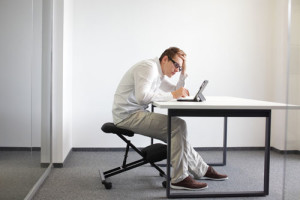
Have you ever sat in a public place and watched people walk by? Probably. Right? Have you seen how people hold their bodies? Some are upright. But many, not so much. We hold ourselves with our neck jutting out forward, or our shoulders slouching, maybe even leaning to one side. Some of us tuck our chins or bend very awkwardly at the waist.
I’ll bet a lot of people don’t even realize they are doing it. But what they are doing to their bodies can be extremely harmful. And this doesn’t just relate to walking but also sitting and standing correctly as well.
In most cases, poor posture can be caused by one of the following factors:
- Accidents, injuries, and falls
- Poor sleep support (mattress)
- Excessive weight
- Foot problems or improper shoes
- Weak muscles, muscle imbalance
- Careless sitting, standing, or sleeping habits
- Negative self-image
- Poorly designed workspace
Poor posture over the long term can cause – fatigue, tight achy muscles in the neck, back and legs, and joint stiffness and pain.
So really! This is something to PAY ATTENTION to.
What can be done? Well mostly, it’s awareness that is going to allow you to stand up straight, sit upright and move without placing yourself in a dangerous situation. Body mechanic wise, this is what you want to do:
Standing –
- Knees should be slightly bent
- Feet about shoulder width apart
- Abs should be tight
- Keep your head level so that your earlobes are in line with your shoulders. Do not push your head forward, backward or to the side
- Stand straight and tall with your shoulders pulled backward
Sitting –
Some of the most common mistakes you can make sitting are: leaning too forward and sitting in a slumped position. This is what you want to do:
- Keep your feet flat on the floor or on a footrest
- Don’t cross your legs
- Relax your shoulders and keep your forearms parallel to the floor especially when doing desk work such as typing on a computer or using a mouse.
- Avoid sitting for long periods of time
Carrying a load and correct lifting positions –
Carrying a backpack, purse or briefcase puts additional stress on your spine and can increase postural sway.
- In order to avoid stress on the spine, a backpack should be carried high in the thoracic region. (think chest level for your back)
- Carrying a purse or a single strap briefcase changes your body’s center of pressure which affects neutral control of your posture. (you want to be in neutral)
Correct lifting –
- When picking up an object that is lower than waist level, keep your back straight and bend at your knees and hips. Do NOT bend forward at the waist with your knees straight.
- Stand with a wide stance close to the object. Tighten your stomach muscles and lift the object using your legs. Straighten your knees in a steady motion.
AWARENESS is key.
Yes, you can also stretch tight muscles and strengthen weak ones. This should be part of any organized exercise program. But in the end, if you don’t check in with yourself once in a while to make sure that your shoulders are back, your abs are tight and you’re in an upright position, then you can easily fall into bad posture. During my training sessions, I’m often heard telling my clients to look straight ahead and keep their heads up. “Your body follows your head” if you’re looking down, then your shoulders are going to slump and your back is going to be in a slouched position.